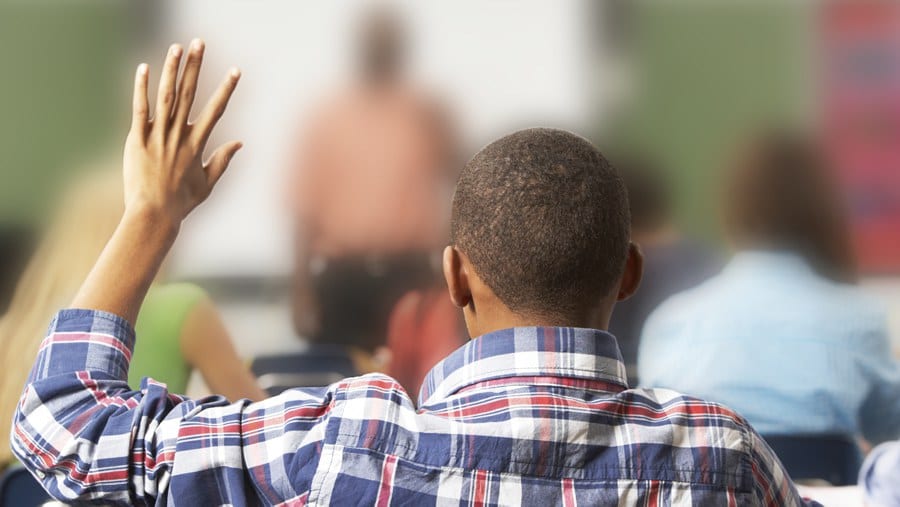Student Contributor: J. Bertrand
 This is simple, non-verbal, “call and response” tool for the classroom. It is a quick way to get student’s attention.
This is simple, non-verbal, “call and response” tool for the classroom. It is a quick way to get student’s attention.
This tool is a quick, simple tool that grabs the attention of the class. As the teacher raises their hand, the students respond by also raising their hand in return. The teacher keeps their hand up until all the students notice and quiet their voices. The teacher can acknowledge in a soft voice the students who immediately notice the signal, and it will help draw in the attention of the other students. The teacher will wait until all the students are quiet and mirroring the hand signal to move onto their message to the class. It is an easy tactic if the teacher needs to tell the class something quick and then allow them to get back to work.
 This preventative phase is teacher-directed and collaborative. It is teacher-directed because it is the instructor getting the attention of the students to add additional information to what the students are working on. It draws their attention away from whatever they are involved with and towards the teacher. This signal is collaborative as well. This is a signal to quickly help the students get the information they need right away from their teacher. It also brings down the noise level of the classroom rather than having students get riled up. This should be taught at the beginning of the year for students to understand as a tool for the classroom.
This preventative phase is teacher-directed and collaborative. It is teacher-directed because it is the instructor getting the attention of the students to add additional information to what the students are working on. It draws their attention away from whatever they are involved with and towards the teacher. This signal is collaborative as well. This is a signal to quickly help the students get the information they need right away from their teacher. It also brings down the noise level of the classroom rather than having students get riled up. This should be taught at the beginning of the year for students to understand as a tool for the classroom.
More Information –
Tool Source: Gus Nollmeyer



I used the silent hand with third graders and noticed that it was really successful in gathering student attention. Silent hand was taught within five minutes and took about a day for students to get the hang of what it looked like and understand their role. They needed to raise their hand and stop talking in order to get instructions. After my third graders understood the way that silent hand worked, it saved a lot of situations because I did not have to match the volume of students to get their attention. Silent hand had instances where I had to wait longer than I would have liked, but it only had its intended effect. In the future, I plan on teaching it earlier in the year rather than when I felt like I really needed it. The only potential improvement I can think of is adding additional signals (like a specific number of fingers in the air) that can direct students to do something specific without talking occurring.
Silent Hand: 45 students, Suburban, k-6th, Preventative, Teacher directed & Collaborative
I had not been placed when I began testing this tool so I tried it in my youth development center, and it has become a daily, normalized tool that the kids expect and respond to. To initially begin, I simply stood up in front of all the seated children and raised my hand. I had a couple children call on me as if they were the teacher, in which case I explained to them, after they called on me, that this was the beginning of something we could all do together. I said, “I will raise my hand and those who raised their hand after me would be thanked, and this congratulatory praise would create a domino effect in which other children will follow suit until the entire group of children has their hands raised and their attention on me.” Students began raising their hand after this explanation. The first time it was tried it worked surprisingly well. I kept at it everyday from then on, and now when the countdown reaches zero for all the children to sit before me, some children raise their hands preemptively, prepared for the tool to begin.
I tested out the tool, silent hand, in a 6th grade classroom of 23 students within a rural school. This tool was fairly easy to prepare and implement in my class. I made sure I created explicit instructions that allowed for the students to quickly and quietly stop what they are doing and direct their attention towards me so that I could give them brief, additional instruction. The students knew that when I gathered their information this way, it would be brief, and they would be able to get back to what they were working on shortly. The tool was very successful in quickly grabbing student’s attention without causing a big disruption. The students quickly learned and understood their role when my hand was raised. A potential improvement for this tool may be being consistent and using whenever I need to add additional information. Sometimes, I forget and quickly speak without using the silent hand signal.
I implemented the Silent Hand in a 4th-grade classroom in a suburban school district with 24 students. The tool was easier to prepare for because it was only a new motion I needed to teach the students during instruction. It was easier to teach the students because in third grade their teacher taught them the quiet symbol to have them help quiet their peers. Instead of being student-directed with the quiet symbol, the students are responsible for controlling their behavior along with their peers when seeing the silent hand come up by a teacher instead. Now using the silent hand symbol is collaborative and teacher-directed. The success I noticed with the tool was students responded faster to this classroom management technique than the techniques used before because they understood the role and knew they had a part to play when the Silent Hand came up. To make this tool even better, try practicing with your students a few times to make a competitive game to see how many seconds it takes for a silent hand to work each time.